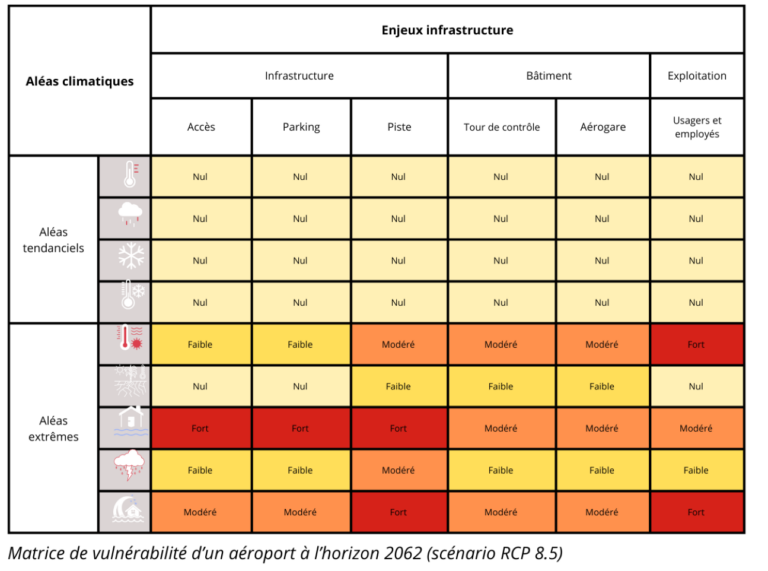Country – France
Objective and approach to vulnerability analysis of two airports
This approach for Vinci, combining accurate climate data and in-depth vulnerability analysis, aims to identify the main risks airports are exposed to. Based on this information, tailor-made adaptation strategies will be developed with the aim of strengthening infrastructure resilience, optimizing operational procedures and ensuring continuity of services in a context of climate change. These results will provide airport managers with essential tools to anticipate future challenges and make informed investment and strategic planning decisions.
The study is structured around two main stages, designed to provide a clear and comprehensive view of the impacts of climate change on infrastructure and airport operations. The first aims to produce climate indicators for assessing sites’ exposure to climate change. The second is a detailed analysis of the vulnerability of airport infrastructure and operations.
Phase 1: Climate exposure indicators
The first phase of this vulnerability analysis consists in analyzing current and future climate data for the two sites studied. Based on high-resolution climate models, projections include parameters such as temperature extremes, precipitation variations and wind intensity. These indicators make it possible to identify phenomena likely to impact airport infrastructures and operations, while taking into account the geographical and environmental specificities of each site.
Analysis of future trends will enable us to identify the main medium-term climatic challenges. For example, increasing episodes of intense heat could affect runway surfaces and reduce their performance, while more frequent precipitation could increase the risk of runway and terminal access flooding.
Phase 2: Vulnerability analysis
The second phase assesses the specific risks faced by airports by cross-referencing exposure indicators with vulnerability criteria specific to infrastructure and operations. This in-depth analysis provides a better understanding of the interactions between climatic hazards and the airport’s various components and sub-components.
The assessment includes the resistance of runways, buildings and equipment to extreme weather conditions, as well as the potential impact on day-to-day operations, such as flight disruptions or operating costs. In addition, factors such as the availability of natural resources (water, energy) and the need to adapt logistical systems are taken into account for a global view of the issues at stake.
Example of a vulnerability analysis :

Airport vulnerability matrix to 2062: Understanding the impact of climate hazards
The vulnerability matrix presented in this diagram enables us to analyze the impact of climate change on airport infrastructures up to 2062, based on the RCP 8.5 climate scenario. This represents a trajectory of high greenhouse gas emissions, leading to significant climate change. The aim of this matrix is to assess the resilience of an airport’s key components, such as buildings, networks and infrastructure systems, to different climate hazards.
Analysis by climatic contingency
he first axis of the matrix refers to climatic hazards, which are divided into two main categories: trend hazards and extreme hazards.. Trend hazards are characterized by slow-moving climatic phenomena, such as the gradual increase in average temperatures or changes in rainfall patterns. These changes, although important in the long term, generally have limited impacts on infrastructure. On the other hand, extreme hazards such as heat waves, storms or floods have a punctual and intense character, which can cause major damage to critical structures and systems.
Infrastructure vulnerability assessment
The second axis of the matrix concerns the infrastructure components of an airport. These are divided into infrastructure (access, parking, runway), building (control tower, terminal) and operation (users and employees). These components are analysed against different climatic hazards to determine their level of vulnerability. This vulnerability is classified according to a colour code ranging from pale yellow (zero vulnerability) to red (strong vulnerability).
The results of this analysis show that trend hazards, although potentially significant in the long term, result in weak or zero vulnerabilities for the components studied. On the other hand, extreme hazards such as flooding and the risk of submersion pose significant risks to infrastructure and operations. These infrastructures are particularly sensitive to extreme weather events, requiring special attention and adaptation measures to ensure their resilience.
Conclusion: Prioritizing the adaptation of airport infrastructures
This vulnerability matrix provides an essential analysis for airport infrastructure managers, enabling them to identify the areas most sensitive to future climate hazards. While the effects of trend hazards can be considered manageable, extreme hazards require urgent adaptation action, particularly for airport systems. heating, ventilation, air conditioning and electricityto minimize negative impacts on airport operations. Based on this analysis, the relevant authorities will be able to better plan and anticipate the investments needed to preserve the integrity of infrastructures in the face of climate change.
What are the recommendations?
The results of this analysis provide essential tools for designing airport-specific adaptation strategies. These strategies will include concrete actions such as the strengthening of critical infrastructure (runways, terminals, hangars) to better withstand extreme weather events, and the optimization of water management systems to prevent flooding.
They will also incorporate the adjustment of operational protocols to limit disruptions linked to climatic events, for example through contingency plans, reinforced maintenance or the use of advanced technologies to anticipate and manage impacts in real time.
These strategies reduce risks and costs in the medium term while ensuring optimal and sustainable airport operations. This proactive approach enhances safety, limits service outages and effectively prepares infrastructure for future climate challenges.
A proactive strategy in the face of climate change
By identifying the main climate risks and proposing concrete measures, this vulnerability analysis helps airport managers anticipate future challenges. It is part of a proactive approach to strengthening the resilience of critical infrastructures to climate change, while minimizing the costs associated with disruptions.
This initiative, integrated with our climate change data services, offers tailor-made expertise to help decision-makers make the transition to sustainable and resilient climate risk management.